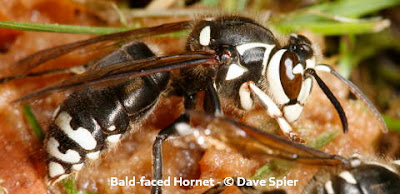This is an insect you want to know in order to avoid it. When they're out collecting food, I can get fairly close without upsetting them, and by moving in slowly I've gotten some decent macro shots of hornets scraping the pulp of fallen pears on the ground. Fruit juice seems to be a favorite food of adults.
Bald-faced Hornets (Vespula maculata) are related to Yellowjackets, Paper Wasps and Potter Wasps in the family Vespidae. At a more general scale, they are in the order Hymenoptera with bees, ants, ichneumons and other wasps. Hornets are large and black with white markings on the face, body [thorax] and tip of the tail [abdomen].
 Only the queens overwinter. In the spring each survivor starts a small nest with one layer of cells an inch or two in diameter. As the new workers emerge, they take over nest building and add larger tiers [layers of cells] underneath, then cover these with an outer, gray, paper-like material made from wood pulp. The round-topped nest usually hangs from a branch, but I've also found them close to the ground in bushes. In fact there's one next to the trail around my property and I've had to flag and "close" that section so the grandkids don't use it. As the nest expands, it tapers toward the bottom where the entrance/exit hole is located. Hornets are most dangerous when you are close to their nest. Unlike bees, hornets can sting repeatedly.
Only the queens overwinter. In the spring each survivor starts a small nest with one layer of cells an inch or two in diameter. As the new workers emerge, they take over nest building and add larger tiers [layers of cells] underneath, then cover these with an outer, gray, paper-like material made from wood pulp. The round-topped nest usually hangs from a branch, but I've also found them close to the ground in bushes. In fact there's one next to the trail around my property and I've had to flag and "close" that section so the grandkids don't use it. As the nest expands, it tapers toward the bottom where the entrance/exit hole is located. Hornets are most dangerous when you are close to their nest. Unlike bees, hornets can sting repeatedly.
In late summer, the males emerge to mate with future queens. As temperatures dip well below freezing in the fall, the males die along with the female workers and old queens and any immature larvae still in the nest. Young queens spend the winter underground or in deep leaf litter.
Corrections, comments and questions are always welcome at northeastnaturalist@yahoo.com Also you can connect through my Facebook photo page at Dave Spier (photographic naturalist) or my personal page, Dave Spier (northeast naturalist).
Photos from this particular blog also appear in an album on my picasaweb site:
https://plus.google.com/photos/113480357145545980499/albums?banner=pwa&gpsrc=pwrd1#photos/113480357145545980499/albums/5207669759008927041
https://plus.google.com/photos/113480357145545980499/albums?banner=pwa&gpsrc=pwrd1#photos/113480357145545980499/albums/5207669759008927041


1 comment:
In response to a comment/question through my Linked-In page: The 2 close-ups were shot on a full-frame Canon 5D with 100mm macro and twin macro flash (although only one side of the flash still works). The hornets were content eating a very ripe pear that dropped to the ground and they didn't mind my getting close. The nest, however, was photographed at a safe distance (about 5') with a long telephoto (a 300mm plus 1.4x extender) on a smaller-sensor Canon XTi and an external 580 flash.
I generally allow non-commercial use of my photos, especially by NPO's. Photos from this particular blog end up in an album on my picasaweb site:
https://plus.google.com/photos/113480357145545980499/albums?banner=pwa&gpsrc=pwrd1#photos/113480357145545980499/albums/5207669759008927041
Post a Comment